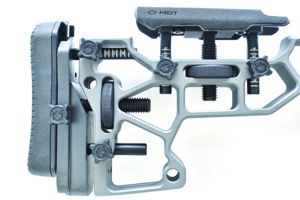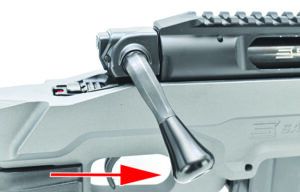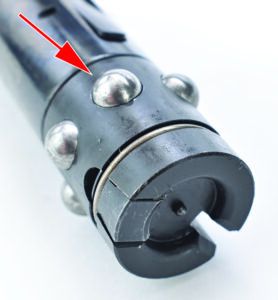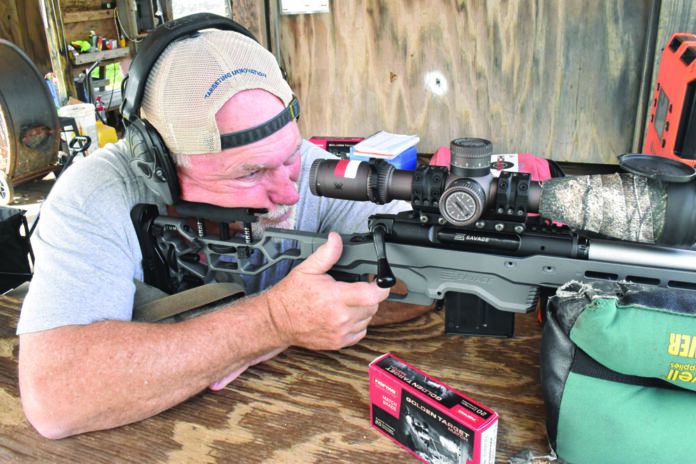The 6.5 Creedmoor cartridge has been one of the hottest rounds in the shooting world the last few years. With chambers and bullets designed for flat trajectory as well as accuracy, the 6.5 CM has proven to be a clear winner for hunters and Hornady, whose engineers designed the cartridge. Almost every rifle platform that comes in mid-caliber chamberings is offered in a 6.5 CM. We recently had the good fortune to test three new offerings chambered for this round:
First was a Savage 110 Elite Precision Impulse with a straight-pull action. It has an MDT chassis and the 26-inch heavy barrel of a PRS-style rifle. We wondered if the straight-pull action would as accurate or as fast as what we accustomed to using for long range shooting.
Next was a somewhat seasoned Tikka T3X CTR one of our test-team members loaned us. It is a bit heavy for what we would normally consider to be a hunting rifle, though it might be great as a beanfield rifle, but it is still a bit light to be a pure competition piece. We wondered if it might fill a spot as a “jack of all trades” choice.
Our final test rifle was the fairly new SIG Sauer Cross. Using a medium-length 18-inch barrel in a lightweight action, we needed to find out if it could shoot and still be easy to carry.
We realized that while we had the same testing process and the same requirements for each rifle, they were slightly different formats and, we thought, warranted slightly different optics. We mounted a Vortex Generation 3 Razor on the Savage. It weighs 45 ounces or thereabout, but then the Gen 2 Razor did as well. This scope is guaranteed forever, for whomever owns the scope and does not require a receipt. They will fix it or replace it — period. List price is $4K, but we found some for sale at Europtics.com for $3K. Note that most of the scopes owned by this team sport camo tape, which keeps us from beating up the objective bell as the optic is shoved in and out of barricades. We used the rock-solid Spuhr SP-4001 mount from MileHighShooting.com, where it runs a bit over $400.

The Tikka T3X CTR also sported a Vortex scope, in this case the Viper PST II 3-15×44. It uses almost the exact same reticle as its more expensive Gen 3 Razor brother. List price is right at $1200, though street price seems to be closer to $1000. Rings are by Warne.
We mounted a Leupold 5HD 3.6×18-44 on the SIG Cross using 35mm Leupold rings. This optic provides great clarity and magnification in a relatively small, light-weight package. Price for this high-quality scope runs in the $2000 range.
So equipped, the rifles had premium ammo fed into them. Our test rounds were Norma’s 143-grain Match bullets, along with Hornady 140-grain ELD-M cartridges, and Berger 144-grain Hybrid Target rounds. Three different ways of packaging the same cartridge in a bolt-action rifle, each of which absolutely had to be able to shoot well. How did they do? We had a blast finding out.
Gun Tests Grade: A-
$2059
These pages and this team are no strangers to Savage Rifles. We have reviewed the company’s Elite Precision chambered in 6mm Creedmoor for the April 2021 Gun Tests. Then came their Axis II in 300 Blackout (March 2022), their Pistol Chassis System (6.5 CM, September 2022), a 110 Tactical (6mm ARC, March 2023) and an Impulse in 22 LR (April 2023). The company’s consistent quality has impressed us, as has its innovations, such as building straight-pull bolt actions. The Impulse chambered in 22 LR was operated with a straight-pull bolt action, then we saw the Impulse straight-pull model sized up and set up to compete in Precision Rifle Series. We needed to know if the new receiver/bolt combination was accurate enough for long-range shooting and whether the straight-pull bolt action really offered any speed advantage.
| Action Type | Bolt |
| Overall Length | 49.0 in. |
| Barrel Length/Twist | 26.0 in.; 1:8 |
| Overall Height w/o Scope Mount | 7.5 in. |
| Weight Unloaded | 12.9 lbs. |
| Weight Loaded | 13.9 lbs. |
| Sight Radius | NA |
| Action | Matte-black stainless steel |
| Barrel | Brushed stainless steel |
| Magazine Capacity | 10 |
| Magazine Type | AICS-pattern detachable box |
| Stock | MDT aluminum chassis |
| Stock Drop at Comb | Adjustable |
| Stock Drop at Heel | 0.75 in. |
| Stock Bedding | None |
| Stock Buttplate | Adjustable, soft rubber |
| Stock Length of Pull | Adjustable |
| Receiver Scope-Base Pattern | Savage |
| Trigger Pull Weight | 1.7 lbs. |
| Safeties | Tang, trigger |
| Warranty | 1-year limited for original owner |
| Telephone | (800) 370-0708 |
| Website | SavageArms.com |
| Made In | U.S. |
The Savage 110 Elite Precision did well in our tests previously. We saw that Savage was utilizing many of the proven parts of this platform and thought that was smart. The tube is a 26-inch button-rifled stainless-steel barrel trimmed to a modified Palma contour. Accuracy is an absolute must for the PRS sport, but other features in the barrel can help as well. One of the nice things about 6.5 Creedmoor match barrels is that they seem to last 2500 to 3000 rounds — your mileage may vary — which is a good bit longer than many other 6mm calibers. The heavy profile pushes the balance point forward, allowing these rifles to rest solidly on bags or barricades at a point about a hand’s width forward of the magazine well, perfect for bag usage. The heavy barrel also heats up more slowly and cools off more quickly. The muzzle is threaded 5⁄8×24, and the rifle comes with a two-port brake that did a great job of taming recoil. The top of the matte-black receiver is capped with a 20-minute-of-angle (moa) Picatinny rail.

The Impulse Elite uses the MDT (Modular Driven Technology, MDTTac.com) chassis, which we applaud. The MDT Adjustable Core Competition chassis can be tailored for length of pull and cheek height. Adjustments are made via knurled wheels that are then locked down with thumb wheels. Our setting stayed tight, and changing the settings didn’t require any tools. The MDT pistol grip will fit on just about any AR-15-style stud, and we’ve liked it well enough to install on other rifles. The grip is hand filling and provides a shelf for thumb placement used with the strong-side thumb grip so popular today. It also allows the shooter to shorten or lengthen the reach to the trigger face, better compensating for different finger lengths. The magazine well is flared and has a bulkhead on the forward edge that acts as a bag or barricade stop. That helps prevent objects the rifle is resting on from hitting the magazine and potentially causing misfeeds. As do many other topnotch rifles today, the Savage uses AICS-pattern magazines, in this case also made by MDT. The mag release is located just in front of the trigger and can be activated easily by either hand. The long fore end has more than 15 inches of M-Lok slots, allowing the installation of accessories or weights. The end cap comes off, creating access to the inside of the fore end. The flat base of the fore end is slotted for an ARCA Swiss rail, facilitating the mounting of most bipods and tripods.
A Savage AccuTrigger is standard on the Impulse Elite. But Savage tweaked it a little. This trigger is adjustable from a floor of 1.5 pounds up to 6 pounds, as desired by the shooter. That’s lighter than their normal set up. It is a single-stage unit, but we always manage the safety in the trigger face as the first stage of a two-stage trigger. Once the trigger safety has been compressed, sear release is crisp, with very little overtravel. Our trigger, straight out of the box, averaged 1.7 pounds with less than 2 ounces standard deviation. A manual thumb safety is located on the tang and activated by pressing to the rear.

Then we come to the bolt. Instead of two or three locking lugs on the bolt head, six ball bearings protrude about half an inch behind the bolt face. When the bolt handle is locked forward, those bearings are cammed out and lock into a ring in the receiver. The bolt handle does not rotate perpendicular to the axis of the bore, but moves, rather, in line with it. The shooter can choose the angle at which the bolt begins its travel and adjustment is easy. The shooter can even choose whether the bolt handle operates from the right or left side of the bolt. The ejector is a hinged unit that sits inside the left part of the receiver. The extractor is held in by a strong clip. The bolt assembly is nitride coated for rust resistance and lubricity.
We didn’t even bore sight the Savage, just mounted the Vortex Gen 3 Razor and went to work. It took us three shots to get on paper at 100 yards and one more to adjust point of impact where we wanted. That used four rounds. Shots five, six, and seven clustered into a 0.474-inch group about a half-inch low. Not a bad start. The Savage seemed to like the Hornady rounds a bit better than the Norma, averaging 0.605 for three-shot groups with the Hornady ammo and right at 0.75 inch for the Norma.
Part of the appeal of the Savage Impulse is the straight-pull action and how quickly they are said to cycle. Of course, we had to run our own tests to find if we could substantiate that claim. We took the Savage Impulse Elite Precision and the Tikka T3X CTR to the 400-yard range at American Shooting Centers. We set up a 20-by-30-inch torso plate and rested the rifles, one at a time, on the Caldwell Shooting bag. The goal was to see how fast we could cycle each action while maintaining enough control to hit the plate. Because the Tikka did not come with a muzzle brake, and control was a very real factor in this test, we added a Badger brake just for this exercise. Using a CED 8000 timer and its random delay feature for the start signal, we began with a loaded magazine in the rifle, and it mounted to our shoulder. Our strong hand rested on the trigger, though the bolt was open. At the signal, we had to properly locate the target, chamber a round, and score three hits as quickly as possible. The Tikka, which is known for its smooth action, required an average of 7.33 seconds for all the movement and the hits. The Savage, drum roll please, averaged 6.45 seconds for the same exercise. That is right at a 12% improvement. Imagine being able to add another 11 seconds to your 90-second par time in the next PRS match.
Our Team Said: Fresh from the factory, the Savage Impulse Elite Precision action was a bit stiff, but no deduction there. The simplicity of movement and the resulting speed of the straight-pull bolt was fascinating. We would love to be able to feel this action after it has been cycled about 2000 times. If it is like other Savages we’ve tested, it would smooth out nicely. If you want an off-the-rack rifle to compete in the PRS Production division, consider the Savage.
6.5 Creedmoor Range Data
All shooting was done at American Shooting Centers in Houston using multiple three-shot groups at 100 yards. All rifles were well-sandbagged in a Caldwell TackDriver Pro (Brownells.com 100-027-023, $49), further supported by a large rear bag, heavy from Tab Gear (TabGear.com, $34). Velocities were measured by LabRadar (MyLabRadar.com, $559).
| Norma Golden Target 143-grain Match | Savage Impulse Elite | SIG Sauer Cross | Tikka T3X CTR |
|---|---|---|---|
| Average Velocity | 2688 fps | 2430 fps | 2598 fps |
| Muzzle Energy | 2295 ft.-lbs. | 1876 ft.-lbs. | 2143 ft.-lbs. |
| Average Group | 0.75 in. | 0.57 in. | 0.44 in. |
| Best Group | 0.53 in. | 0.46 in. | 0.21 in. |
| Hornady Match 140-grain ELD-M | Savage Impulse Elite | SIG Sauer Cross | Tikka T3X CTR |
| Average Velocity | 2698 fps | 2542 fps | 2596 fps |
| Muzzle Energy | 2264 ft.-lbs. | 2009 ft.-lbs. | 2096 ft.-lbs. |
| Average Group | 0.61 in. | 0.46 in. | 0.41 in. |
| Best Group | 0.47 in. | 0.30 in. | 0.22 in. |
| Berger Long Range 144-grain Hybrid Target | Savage Impulse Elite | SIG Sauer Cross | Tikka T3X CTR |
| Average Velocity | 2798 fps | 2604 fps | 2734 fps |
| Muzzle Energy | 2504 ft.-lbs. | 2169 ft.-lbs. | 2391 ft.-lbs. |
| Average Group | 0.86 in. | 0.48 in. | 1.23 in. |
| Best Group | 0.65 in. | 0.33 in. | 1.07 in. |


























